| Article ID | Journal | Published Year | Pages | File Type |
|---|---|---|---|---|
| 6971721 | Journal of Hazardous Materials | 2013 | 6 Pages |
Abstract
A novel dielectric barrier discharge (DBD) reactor was applied for removal of H2S. Activated carbon fiber (ACF) and a photocatalytic electrode prepared from sintered metal fibers (SMF) were introduced into the novel reactor. H2S removal rate was enhanced dramatically due to the synergism between DBD and ACF. Peak voltage, initial concentration, resident time and humidity were important factors that influenced the H2S removal rate. 75Â mg/m3 H2S removal rate reached 99.9% at a peak voltage of 25Â kV and with a resident time of 2Â s in the novel reactor. Humidity had an inhibition to H2S decomposition at low peak voltages. And the inhibition became slight at high peak voltages (>20Â kV). The novel reactor exhibited better by-products (SO2 and O3) control than other reactors did. And it also had excellent performance stabilization in a long-term operation (30 d).
Related Topics
Physical Sciences and Engineering
Chemical Engineering
Chemical Health and Safety
Authors
Jie Chen, Zhenmiao Xie,
